A+P II Chp 25: Urinary System
1/142
There's no tags or description
Looks like no tags are added yet.
Name | Mastery | Learn | Test | Matching | Spaced |
|---|
No study sessions yet.
143 Terms
What are 4 urinary system organs?
1) kidneys
2) urinary bladder
3) paired ureters
4) urethra
What do the kidneys do?
form urine
What is the function of the urinary bladder?
stores urine temporarily
What do the paired ureters do?
transport urine from kidneys to bladder
What does the urethra do?
transports urine from the bladder out of the body
For the kidney,
a) is it retroperitoneal or intraperitoneal
b) what region is it located in
c) which kidney is lower
d) what 2 surfaces does it have
a) retroperitoneal
b) superior lumbar region
c) right kidney
d) convex lateral surface, concave medial surface
What is the renal hilum?
- leads to renal sinus
- where ureters, blood vessels, lymphatics, and nerves enter/exit
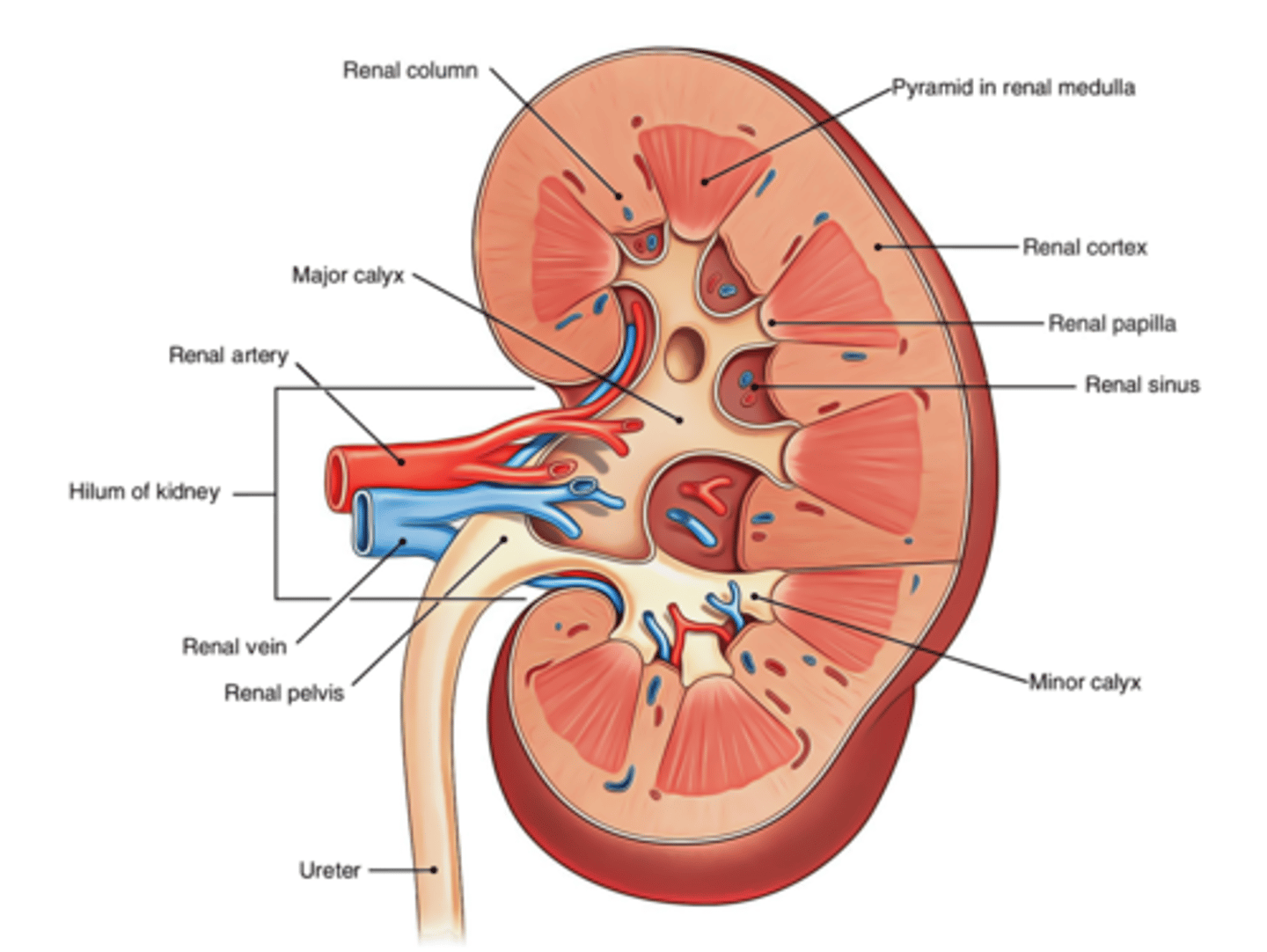
What are the 3 layers of supportive tissue in the kidneys?
1) renal fascia: outer layer of dense CT
2) perirenal fat capsule: fatty cushion
3) fibrous capsule: prevents infection
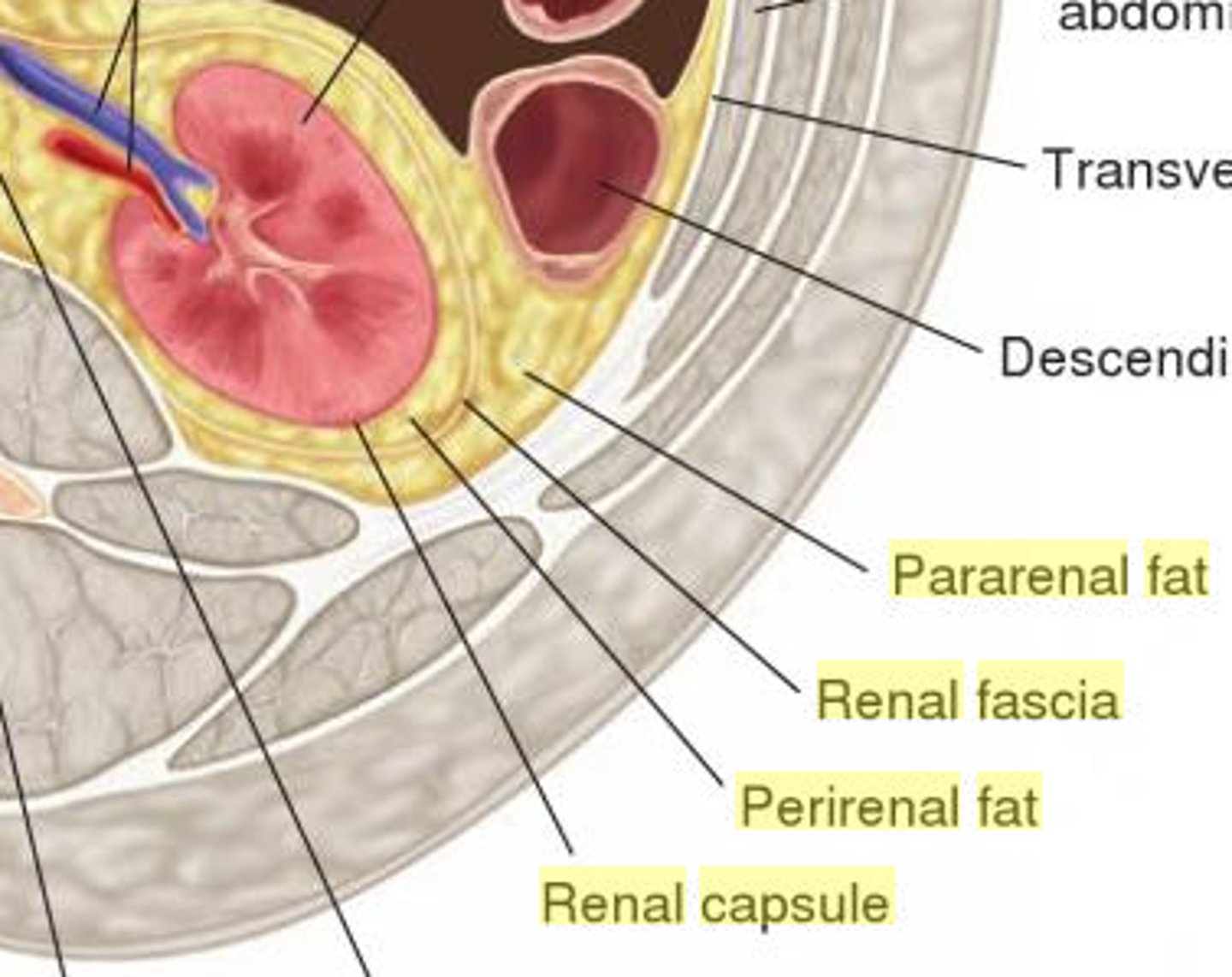
What are the 3 regions of the internal kidney?
1) renal cortex: granular superficial region
2) renal medulla: deep to cortex
3) renal pelvis: funnel-shaped tube within renal sinus
What 3 things is the renal medulla composed of?
1) medullary (renal) pyramids
2) renal columns
3) 8ish lobes
What are the 2 parts of the medullary pyramids?
1) broad base faces cortex
2) papilla (tip) points internally
What do renal columns do?
separate renal pyramids
What is a kidney lobe?
medullary pyramid + surrounding cortical tissue
The renal pelvis is continuous with _________.
ureter
What are the 2 parts of the kidney that flow into the renal pelvis?
minor calyces (collect urine from papillae) --> major calyces --> renal pelvis
What is the pathway of urine flow through the kidney?
1) renal pyramid (and papillae)
2) minor calyx
3) major calyx
4) renal pelvis
5) ureter
What is the blood supply for the kidneys?
1) renal arteries: deliver 1/4 of cardiac output
2) venous flow out of kidney
What is the nerve supply for the kidneys?
sympathetic fibers from the renal plexus
What is the path of blood flow through the renal blood vessels?
1) aorta
2) renal artery
3) segmental artery
4) interlobar artery
5) arcuate artery
6) cortical radiate artery
7) afferent arteriole
8) glomerulus (capillaries)
9) efferent arteriole
10) peritublar capillaries/vasa recta
11) cortical radiate vein
12) arcuate vein
13) interlobar vein
14) renal vein
15) inferior vena cava
Where is each located?
a) segmental artery
b) interlobar artery/vein
c) arcuate artery/vein
d) cortical radiate artery/vein
a) renal sinus
b) renal columns
c) border of cortex and medulla
d) in the cortex
Which 3 renal blood vessels are part of the renal corpuscle?
1) afferent arteriole
2) glomerulus (capillaries)
3) efferent arteriole
What is the nephron?
structural and functional unit that forms urine
What are the 2 main parts of the nephron?
1) renal corpuscle: glomerulus (capillaries) + Bowman's/renal capsule
2) renal tubule
What are the 2 layers of the glomerular capsule (aka Bowman's capsule)? What type of cells is each made up of?
1) parietal layer: simple squamous epithelium
2) visceral layer: branching epithelial podocytes
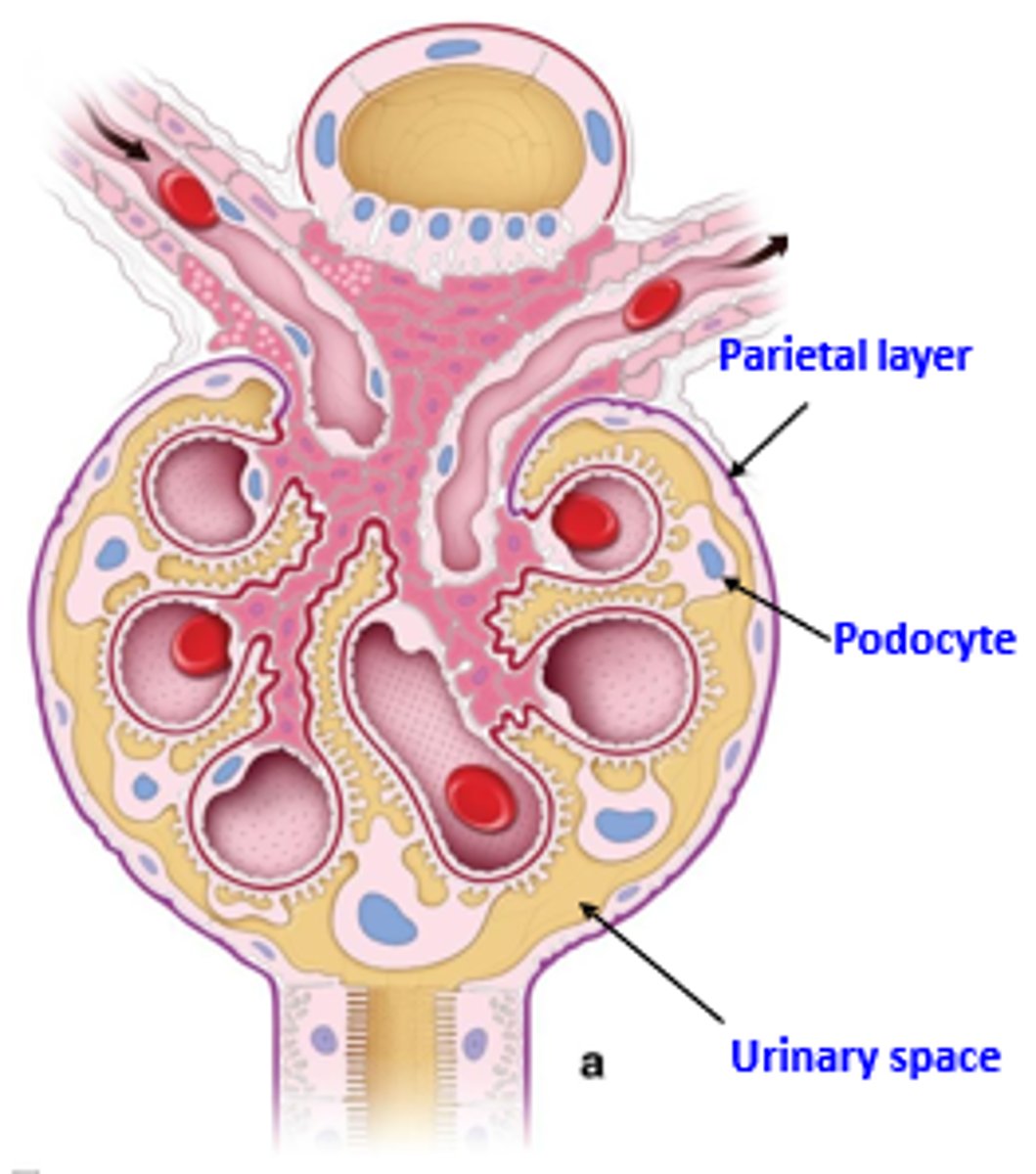
What are 2 characteristics of podocytes?
1) foot processes cling to basement membrane
2) filtration slits allow filtrate to pass through
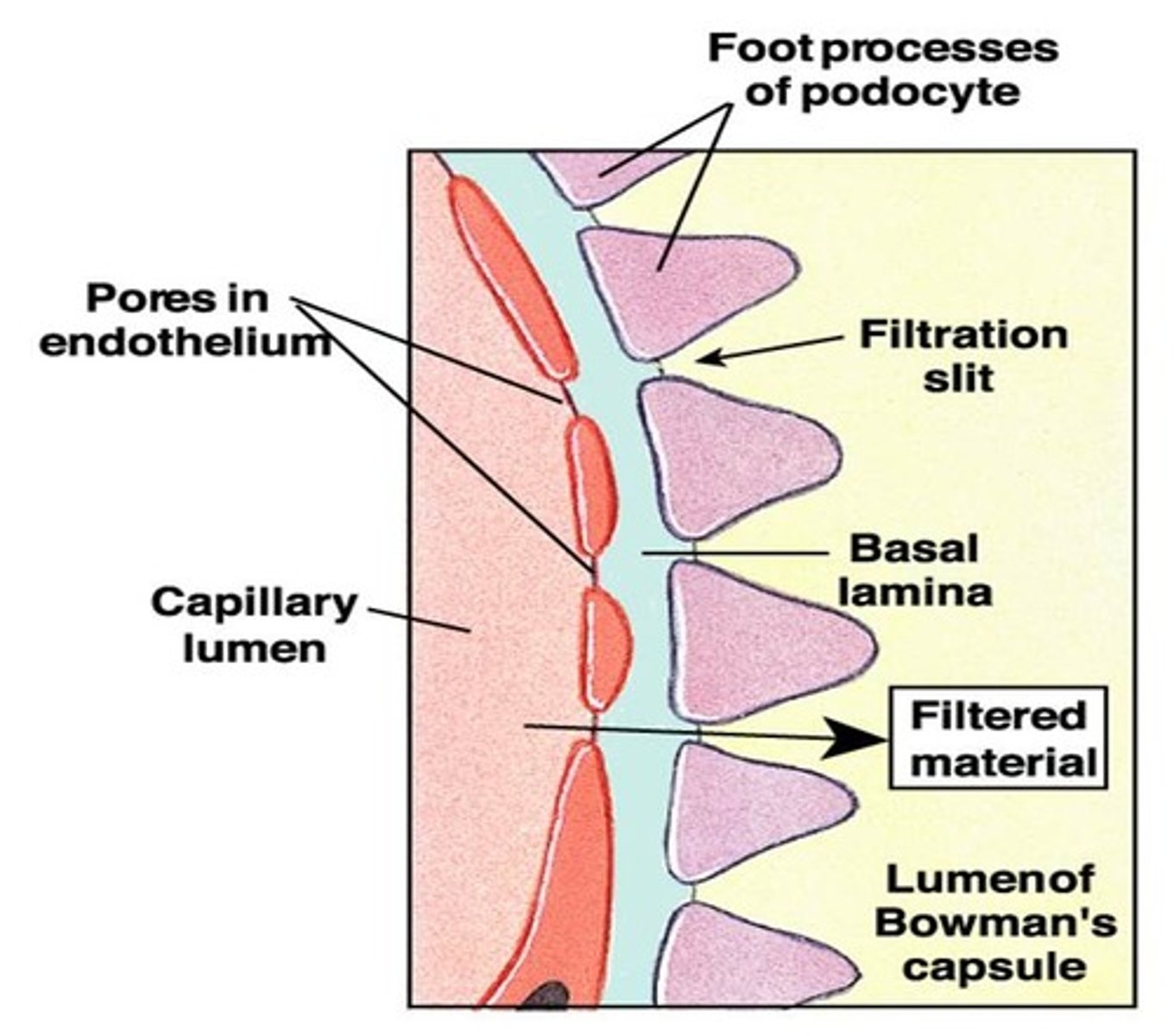
What are the 3 major parts of the renal tubule?
1) proximal convoluted tubule (PCT)
2) nephron loop/loop of Henle (ascending + descending loops)
3) distal convoluted tubule (DCT)
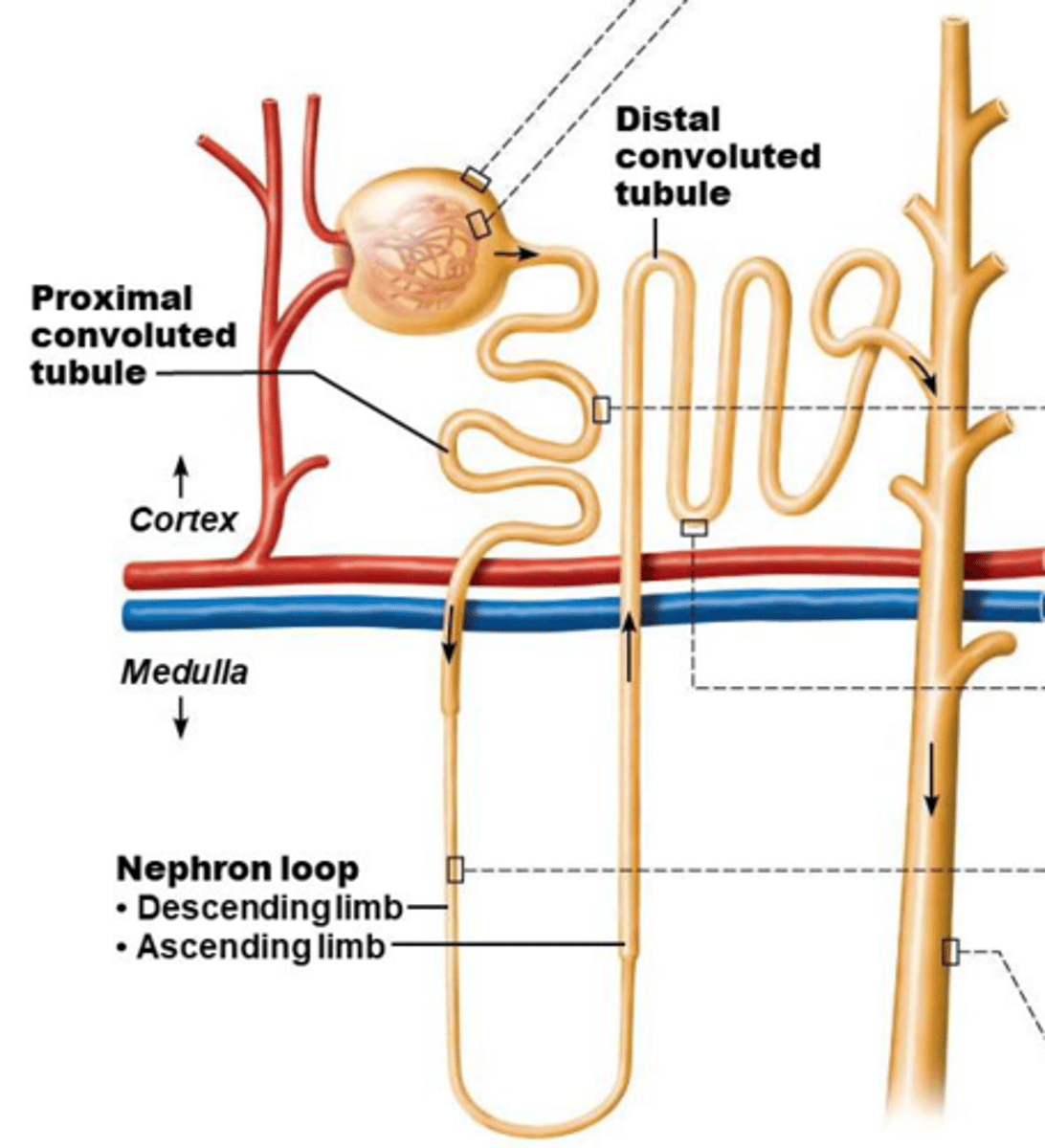
For the PCT,
a) what is the histology
b) what is the function
c) where is it located
a) cuboidal cells with dense microvilli
b) reabsorption and secretion
c) confined to cortex
For the nephron loop,
a) what is the histology of the descending limb
b) what is the histology of the ascending limb
a) thin, simple squamous epithelium
b) thick, cuboidal to columnar cells
For the DCT,
a) what is the histology
b) what is the function
c) where is it located
a) cuboidal cells with very few microvilli
b) more secretion than reabsorption
c) confined to cortex
Regarding collecting ducts,
a) what forms them
b) what do they form
a) many nephrons
b) fuse together to deliver urine through papillae into minor calyces
What are the 2 types of cells in the collecting ducts?
1) intercalated cells
2) principal cells
For intercalated cells,
a) what is the histology
b) what is the function
a) cuboidal cells with microvilli
b) maintain acid-base balance
For principal cells,
a) what is the histology
b) what is the function
a) cuboidal cells without microvilli
b) maintain body's water/salt balance
What are the 2 types of nephrons?
1) cortical nephrons: 85%
2) juxtamedullary nephrons: 15%
For the cortical nephron,
a) where is it located
b) how long is the loop of Henle
c) where is the glomerulus located
d) what does the efferent arteriole supply
a) entirely in cortex
b) short
c) further from corticomedullary junction
d) peritubular capillaries
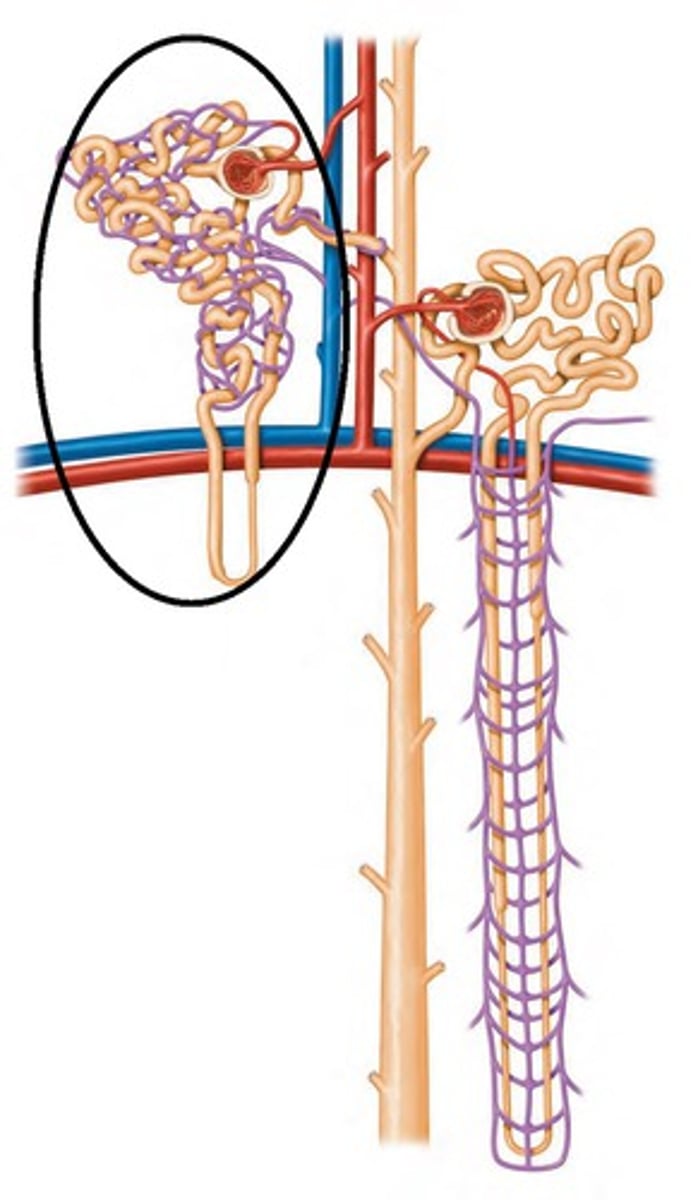
For the juxtamedullar nephron,
a) where is it located
b) how long is the loop of Henle
c) where is the glomerulus located
d) what does the efferent arteriole supply
a) mostly deep in medulla
b) long
c) closer to corticomedullary junction
d) vasa recta
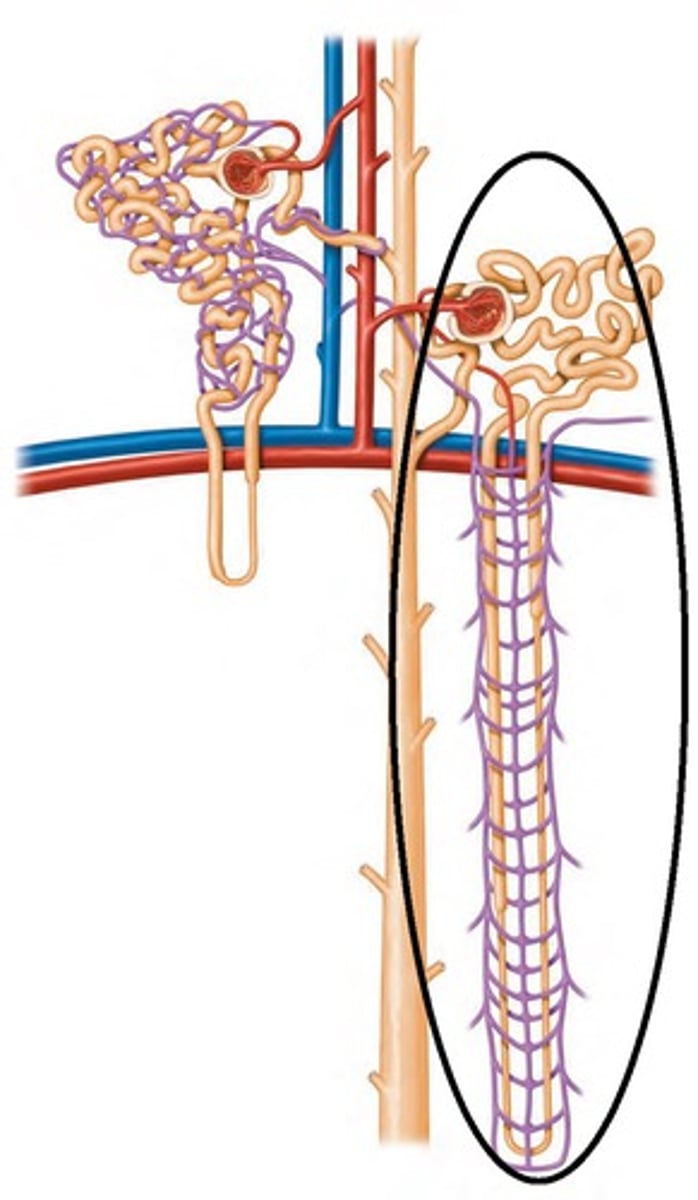
For juxtamedullary nephrons,
a) are the segments thick or thin?
b) what is their main function
a) thin
b) production of concentrated urine
Which 2 capillary beds are the renal tubules of each nephron associated with?
a) cortical nephron
b) juxtamedullary nephrons
a) glomerulus + peritubular capillaries
b) glomerulus + vasa recta
For the glomerulus,
a) what is the pathway through it
b) what is its function
c) are they high or low pressure
a) afferent arteriole --> glomerulus --> efferent arteriole
b) filtration
c) high BP
Why is the BP high in the glomerulus? (3 reasons)
1) afferent arterioles have a larger diameter than efferent arteriole
2) arterioles are high-resistance vessels
3) to filter all the blood
For peritubular capillaries,
a) are they high or low pressure
b) what is their function
c) what is the pathway through it
d) what do they surround
a) low
b) absorption
c) efferent arterioles --> peritubular capillaries --> venules (cortical radiate vein)
d) only tubules in cortex
For vasa recta,
a) from where do they arise
b) what is their function
c) what do they surround
a) efferent arterioles of juxtamedullary nephrons
b) concentration of urine
c) only the long loop of Henle
Each nephron has one juxtaglomerular apparatus (JGA). What is the JGA important for?
regulation of filtrate formation + BP
What are the 2 modified portions of the JGA?
1) distal portion of ascending limb
2) afferent arteriole
What are the 2 cell types of the JGA?
1) granular/juxtaglomerular cells
2) macula densa
For JG cells,
a) what are they
b) what do they contain
c) what is their function
a) smooth muscle cells of arteriole
b) renin
c) mechanoreceptos: sense BP
For macula densa,
a) what are they
b) what is their function
a) cells of the ascending limb
b) chemoreceptors: sense NaCl content in filtrate
What is the kidney's filtration membrane?
porous membrane between the blood (glomerular capillaries) + the capsular space
What are the 3 layers of the filtration membrane (from innermost to outermost)?
1) fenestrated endothelium: glomerular capillaries
2) gel-like basement membrane: fused basal lamina
3) visceral membrane (of glomerular capsule): podocytes
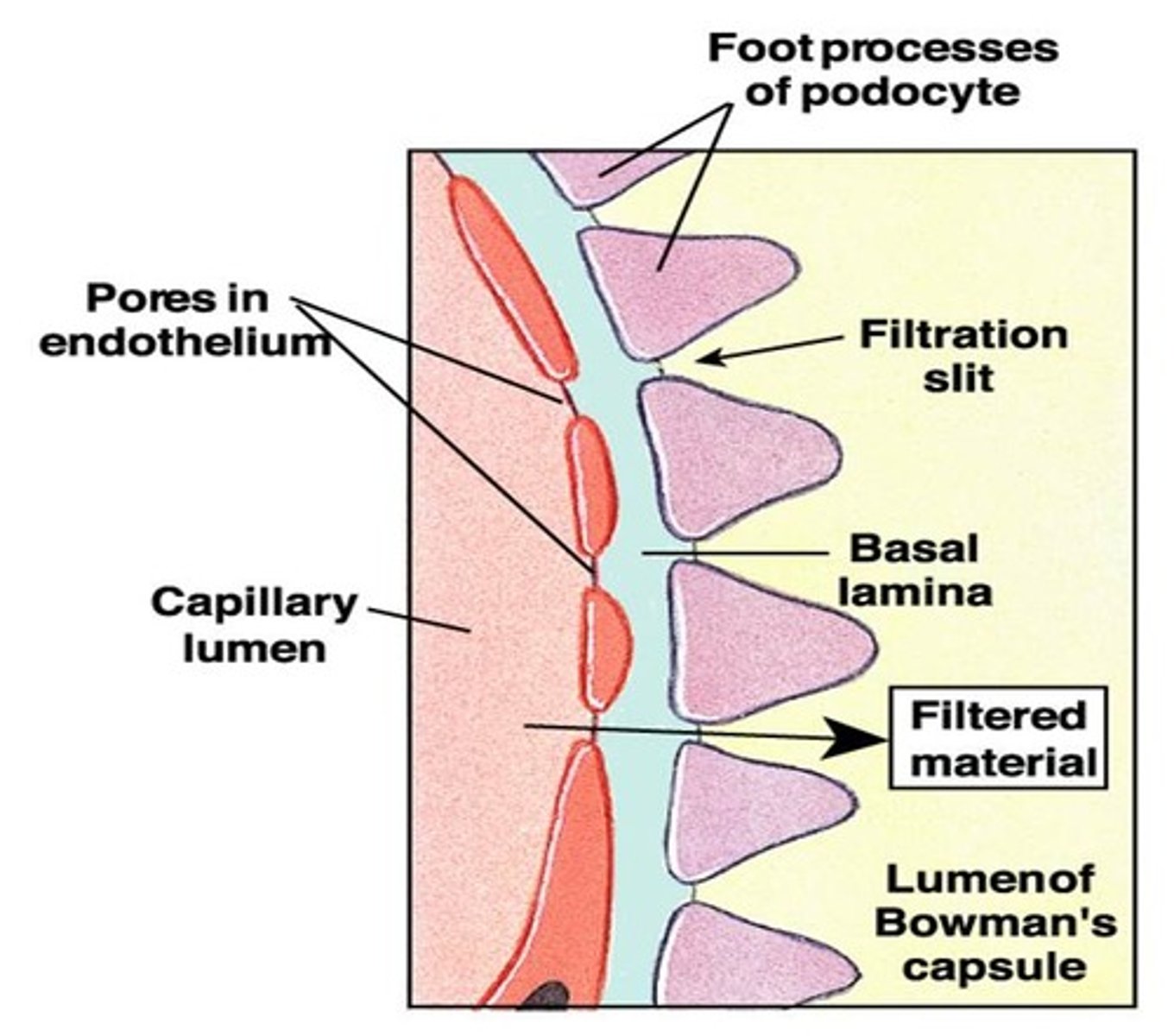
For ureters,
a) what do they do
b) are they retroperitoneal or intraperitoneal
c) how do they enter the bladder
a) convey urine from kidneys to bladder
b) retroperitoneal
c) enter the base through posterior wall
As bladder pressure increases, what do ureters do?
distal ends close, preventing backflow of urine
What are the 3 layers of the ureter wall?
1) transitional epithelium
2) smooth muscle muscularis: contracts due to stretch
3) adventitia: fibrous CT
For the urinary bladder,
a) what is it
b) is it retroperitoneal or intraperitoneal
c) what gland surrounds its neck in males
d) where is it located in females
a) muscular sac that temporarily stores urine
b) retroperitoneal
c) prostate gland
d) anterior to vagina and uterus

What is the trigone?
- part of the urinary bladder
- triangular area: 2 opening for ureters at top, 1 opening for urethra at bottom
- infections persist here
What are the 3 layers of the bladder wall?
1) transitional epithelial mucosa
2) detrusor muscle (smooth muscle)
3) fibrous adventitia
When do rugae in the urinary bladder appear?
when the urinary bladder is empty/collapses
What is the importance of the urogenital diaphragm?
it supports the urethra and maintains urinary/reproductive functions (ex: peeing and ejaculation)
The urethra is a muscular tube. What is its histology? (it changes)
- mostly pseudostratified columnar epithelium
- transitional epithelium near bladder
- stratified squamous epithelium near external urethral orifice
What are the 2 sphincters of the urethra (and what muscle makes up each)?
1) internal urethral sphincter: involuntary/smooth muscle
2) external urethral sphincter: voluntary/skeletal muscle
Where is each sphincter located?
a) internal urethral sphincter
b) external urethral sphincter
a) contracts to open at bladder-urethra junction
b) surrounds urethra as it passes through the pelvic floor
What are 2 differences between the female and male urethra?
1) male urethra is longer
2) male urethra carries both semen and urine (female urethra only carries urine)
For the female urethra,
a) what is it bound to
b) what is the external urethral orifice located between
a) anterior vaginal wall
b) anterior to vaginal opening, posterior to clitoris
What are the 3 regions of the male urethra? (from superior to inferior)
1) prostatic urethra
2) membranous urethra
3) spongy urethra
Where is each region of the male urethra located?
a) prostatic urethra
b) membranous urethra
c) spongy urethra
a) prostate gland
b) passes through urogenital diaphragm
c) passes through penis to open via external urethral orifice
What are 5 kidney functions?
1) removal of toxins, metabolic wastes, excess ions from blood
2) regulation of BV, chemicals, and pH
3) gluconeogenesis during fasting
4) endocrine functions: renin and erythropoietin
5) activation of vit D
How does each contribute to the endocrine function of the kidney?
a) renin
b) erythropoeitin
a) regulates BP
b) regulates RBC production
What does high resistance in afferent and efferent arterioles cause?
BP to decline from ~95 mmHg to ~8mmHg in kidneys
What is filtrate made up of?
blood plasma minus proteins
For urine,
a) how much of the total filtrate does it make up
b) what does it contain
a) <1%
b) metabolic wastes + unneeded substances
What are the 3 mechanisms of urine formation?
1) glomerular filtration: dumping everything
2) tubular reabsorption: removes stuff from urine (reclaiming in blood)
3) tubular secretion: adds stuff to urine
Glomerular filtration is a passive mechanical process driven by ____________________.
hydrostatic pressure
Why is the glomerulus a very efficient filter? (2 reasons)
1) its membrane is very permeable with a large SA
2) glomerular BP is higher than other capillaries
Molecules >5nm, like ______________, are not filtered and function to maintain ____________________ of the blood.
plasma proteins; colloid osmotic pressure
What is the net filtration pressure (NFP)?
the pressure responsible for filtrate formation (10 mmHg)
Which 3 forces determine NFP?
1) chief force: glomerular hydrostatic pressure (HPg)
2) opposing force: colloid osmotic pressure (OPg)
3) opposing force: capsular hydrostatic pressure (HPc)
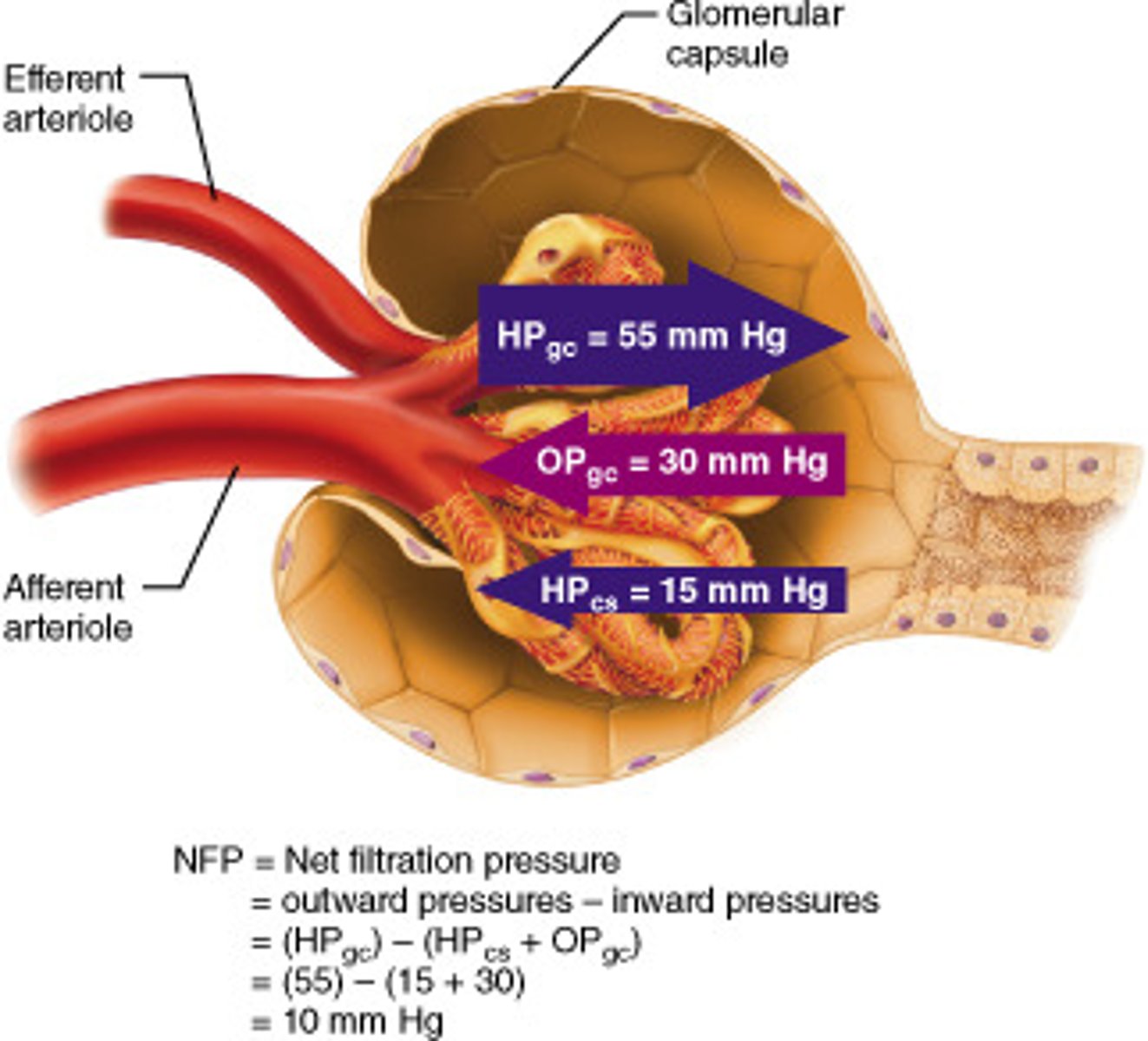
What is the pressure of each force?
a) HPg
b) OPg
c) HPc
a) 55mmHg
b) 30mmHg
c) 15mmHg
What is the equation to determine NFP? Solve it.
1) NFP = HPg - (OPg + HPc)
2) NFP = 55 - (30 + 15)
3) NFP = 10mmHg
What would happen if the glomerular hydrostatic pressure (HPg) were less than 55 mmHG?
the glomerulus would have trouble pushing blood/fluids (or can't push fluids at all if less than 45mmHg)
What is the glomerular filtration rate (GFR)?
volume of filtrate formed per minute by the kidneys
What 3 things is the GFR governed by (and directly proportional to - meaning if it's greater, then GFR is greater)?
1) total SA available for filtration
2) filtration membrane permeability
3) NFP
GFR is tightly controlled by which 2 types of mechanisms?
1) intrinsic controls (renal autoregulation): within the kidney
2) extrinsic controls: nervous and endocrine mechanisms
Intrinsic controls maintain a nearly constant GFR. What are the 2 types of renal autoregulation?
1) myogenic mechanism: regulated by muscles in blood vessels
2) tubuloglomerular feedback mechanism: senses changes in the JGA
Regarding the myogenic mechanism, what happens when...
a) BP increases
b) BP decreases
a) afferent arterioles constrict --> less blood flow --> lower GFR/NFP to normal
b) afferent arteriole dilate --> more blood flow --> raise GFR/NFP to normal
What happens in tubuloglomerular feedback mechanism?
macula densa senses the NaCl concentration of the filtrate + regulates the vasodilation/constriction of afferent arteriole
Regarding the tubuloglomerular feedback mechanism, what happens when...
a) NaCl conc is high
b) NaCl conc is low
a) more salt --> high GFR --> macula densa constricts afferent arteriole
b) less salt --> low GFR --> macula densa dilates afferent arteriole
What are the 2 mechanisms of extrinsic control?
1) neural mechanism: sympathetic control
2) hormonal mechanism: renin-angiotensin mechanism
Which mechanism (intrinsic or extrinsic) is GFR controlled by in each situation?
a) sympathetic NS is at rest
b) sympathetic NS is active/under stress
a) intrinsic controls: blood vessels dilated
b) extrinsic controls: blood vessels constrict
Under stress,
a) which 2 hormones are released
b) what do afferent arterioles do
a) norepinephrine + epinephrine (from adrenal medulla)
b) constrict and inhibit filtration
What happens if someone is under too much stress (such as having a surgery)?
too much constriction --> kidneys shut down --> dialysis needed to keep person alive until they're stable
What are the steps of the renin-angiotensin mechanism?
1) JG cells release renin
2) renin: angiotensinogen to angiotensin I
3) angiotensin converting enzyme (ACE): angiotensin I to angiotensin II
What 2 things does angiotensin II do?
1) causes systemic and glomerular hydrostatic pressure to rise
2) releases aldosterone
What are 3 methods of tubular reabsorption?
1) ATP: primary and secondary
2) passive transport: diffusion, facilitated diffusion, osmosis
3) water + ion reabsorption: controlled by hormones
What are the 2 routes of tubular reabsorption? (from lumen into blood)
1) transcellular: across cell
2) paracellular: between cells
What is the transcellular route? (4 steps)
1) apical membrane of tubule cells
2) cytosol of tubule cells
3) basolateral membrane of tubule cells
4) endothelium of peritubular capillaries
What is the paracellular route?
What are some molecules that take this route?
- between cells
- limited by tight junctions, but leaky in proximal nephron
- water and some ions get reabsorbed in the PCT
What are 3 things that get reabsorbed?
1) all nutrients: glucose + amino acids
2) ions
3) water
_____ is the most abundant cation in filtrate.
Na+
How is Na+ transported across the...
a) basolateral membrane
b) apical membrane
a) primary transport via Na+-K+ ATPase pump: maintains sodium gradient
b) secondary active transport
How are glucose, amino acids, ions, and vitamins reabsorbed by the kidneys? (4 steps)
1) sodium gradient created
2) low intracellular Na+
3) nutrients cotransported with Na+ into cell (secondary active transport)
4) facilitated diffusion out of cell to peritubular capillaries
How is water reabsorbed by the kidneys? (3 steps)
1) movement of Na+/other solutes creates osmotic gradient
2) goes through aquaporins: water-filled pores
3) water is reabsorped passively to peritubular capillaries